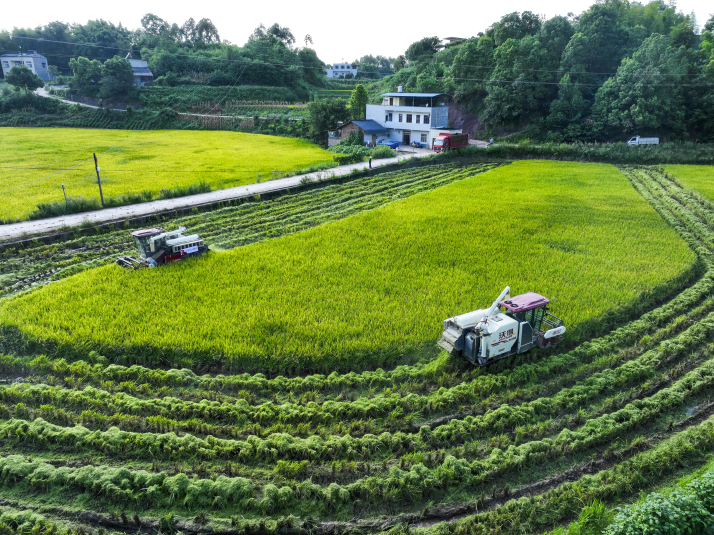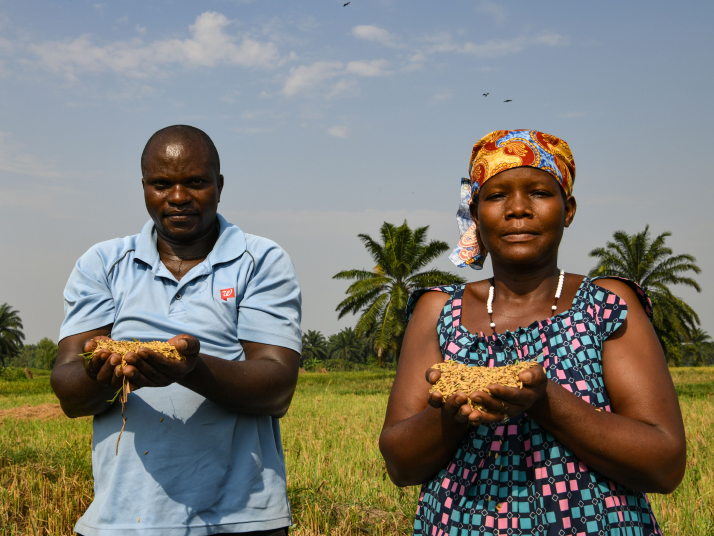| World |
| To be food secure or not to be | |
|
|
 Mechanized rice harvesting operations in Chongqing Municipality on August 13 (XINHUA)
Halfway through 2023, a worrying pattern has emerged. "Rare" and "record-breaking" have become ubiquitous terms, used to describe an onslaught of extraordinary weather events worldwide. Freakish heatwaves, mega droughts, flash floods—climate change has loaded the dice for more frequent and intense extreme weather events. Bouts of chaotic weather are posing an existential threat to feeding humanity. Troubling reality From February 5 to March 14, cyclone Freddy pummeled Malawi, Mozambique, Madagascar and Zimbabwe with punishing winds and flooding rains. Sustained for over five weeks, Freddy set new global records for longevity and accumulated storm energy. The impacts of the cyclone on humanity have been staggering. According to the United Nations World Food Programme, nearly 2.3 million people lost critical crops and livestock. The relentless tempest destroyed over 180,000 hectares of farmland. In sum, Freddy has plunged 1.3 million people into severe food insecurity. But Freddy is not the only example of extreme weather threatening food security. In late May and early June, Henan Province and several other major summer grain-producing regions in central China were hit by a highly unusual bout of "field-rotting rains" during the wheat harvest. The rainfall caused widespread mold and pre-harvest sprouting of the ripening wheat crop, which greatly disturbed crop production. According to estimates, 250-300 million tons of wheat were affected, with sprouting grains being unfit for human consumption. In North America, extreme heat and drought disrupted the U.S. breadbasket, a term used to describe the Great Plains, an agricultural factory of immense proportions and a significant grain-growing region on the North American continent. According to the U.S. Drought Monitor report, released by the U.S. Department of Agriculture on June 29, key agricultural regions there had seen an alarming intensification of the drought. Seventy percent of corn and 63 percent of soybean areas were experiencing some level of drought—the longest dry spell since 2012 for both critical crops. Crop conditions had plunged to their lowest point since 1988, indicating potential calamity for production. But the threats extreme weather poses to food security go well beyond diminished crop yields, Wang Jinxia, Director of the China Center for Agricultural Policy at Peking University, explained to Beijing Review. "The impacts also include a lowered quality of agricultural products, and heightened risks of crop epidemics," she elaborated. "Furthermore, extreme weather events can negatively impact farmers' livelihoods and reinforce economic pressures." This, Wang noted, can stir market volatility and reverberate through food supply and pricing. The multidimensional risks extreme weather presents to agriculture and nutrition security must not be underestimated, Wang stressed. The 2023 Global Report on Food Crises published by the Food Security Information Network, a technical global platform on food security and nutrition analysis, on May 2 stated that, in 2022, for the fourth consecutive year, the number of people facing acute severe food insecurity and in urgent need of food, nutrition and livelihood assistance reached the highest level since the report started seven years ago. Around 258 million people across 58 countries today face severe food crises. Although factors like geopolitical conflicts do play a role, extreme weather events are one of the major driving factors. China's actions On July 1, the Extreme Weather and Food Security Symposium convened in Beijing. Organized by the China Agricultural Risk Management Association, the conference gathered officials, experts and scholars from a range of fields. Participants discussed how to address the impact of extreme weather on China's food security. A significant contributor to the rise in extreme weather events this year has been the abrupt shift in El Niño conditions. This follows a three-year La Niña phase, unfolding against the larger context of global warming. El Niño is a climate pattern that describes the unusual warming of surface waters in the eastern tropical Pacific Ocean. By contrast, La Niña is associated with cooler than average ocean surface temperatures there. While La Niña tends to suppress extremes, El Niño exacerbates human-caused climate change, driving even hotter temperatures and other dangerous weather. Participants concurred the rapid transition from La Niña to El Niño has amplified meteorological instabilities. They proposed that bolstering capabilities to respond to climate change and extreme weather should be a key priority in protecting food security. Concrete recommendations included: shifting the focus from post-disaster relief to pre-disaster prevention; evolving from reacting to singular disaster types to integrated disaster mitigation; shifting from minimizing disaster losses to reducing disaster risks; optimizing industry layouts and crop mixes; augmenting agricultural infrastructure; and advancement of remote sensing and other cutting-edge technologies to enhance disaster prevention, mitigation, forecasting and early warning. "For China, food security remains an enduring priority. China's massive population puts pressure on its land resources, and while total land area is substantial, arable land per capita is small. All in all, China is still a country facing resource scarcity," Si Wei, Dean of the College of Economics and Management at China Agricultural University, said in an interview with 21st Century Business Herald, a leading financial and economic media outlet in China. A crucial response China has undertaken in recent years to ensure food security is advancing high-standard farmland development. "High-standard farmland denotes contiguous, well-outfitted plots of arable land that, through improvements over time, have become primary land for modern agricultural production," Wang told Beijing Review. "Specifically, these fields feature integrated infrastructure, high and consistent yields, ecological sustainability, and less vulnerability to natural disasters."  Farmers hold up hybrid rice grains in the fields in Gihanga District of Bubanza Province, Burundi, on June 20. China has dispatched agricultural experts to different parts of the African country to provide local rice farmers with technical guidance since August 2009 (XINHUA)
Common goal In 2015, all UN member states adopted the 2030 Agenda for Sustainable Development, including a set of 17 interconnected Sustainable Development Goals (SDGs). The Zero Hunger SDG focuses on finding sustainable solutions to stop world hunger. In an interview with a newspaper run by the Central Commission for Discipline Inspection of the Communist Party of China, Fan Shenggen, chair professor and Dean of the College of Global Food Economics and Policy at China Agricultural University, identified insufficient political will as the primary impediment to achieving the Zero Hunger goal. "In economically disadvantaged regions, government officials often prioritize short-term political interests over long-term development objectives," Fan explained. "This focus on immediate gains over sustainable progress hinders effective policy implementation and strategic response to complex challenges." According to Fan, food security and poverty alleviation are interdependent. Reducing poverty can increase people's purchasing power and economic capacity, enabling them to buy adequate food and improve dietary quality. It can also promote rural development and growth in agricultural production, thereby boosting food supply and farmer income. He called for greater measures to increase agricultural investment, raise agricultural productivity, and improve infrastructure and social safeguards, in order to realize the dual goals of food security and poverty alleviation. The 13th BRICS (the acronym for the grouping of Brazil, Russia, India, China and South Africa) Ministers of Agriculture meeting, which took place in South Africa's Limpopo Province from August 9 to 12, echoed Fan's measures. According to the meeting's media release, the ministers made a joint appeal to address the impacts of climate change on food security and agriculture. They called for increased means of implementation to be made available to developing nations, allowing them to boost the adaptive capacity and resilience of people, food systems and agricultural production in the face of climate change. Additionally, they voiced their support for the adoption of top-notch agricultural practices, such as integrated crop-livestock production systems, aligning with internationally agreed objectives, such as the SDGs. "International cooperation is among the most effective approaches for addressing climate change's threats to food security," Wang said. "With the global, multidimensional challenges of climate change upon us, collaboration between the BRICS nations—the 'ballast stone' of worldwide food security, as the five countries account for over 50 percent of the world's total agricultural output value, feeding 42 percent of the global population—has become more crucial than ever." Wang stressed that the BRICS nations can leverage broader cooperation to share data, technologies and resources for boosting agricultural production. They also need to collaborate to raise public awareness of climate change risks and response strategies among their populations. Additionally, by boosting joint financing and investment, instituting regular high-level policy dialogues, and forging unified stances, the BRICS can contribute to advancing international climate negotiations. Copyedited by G.P. Wilson Comments to zhaowei@cicgamericas.com |
|
||||||||||||||||||||||||||||
|
